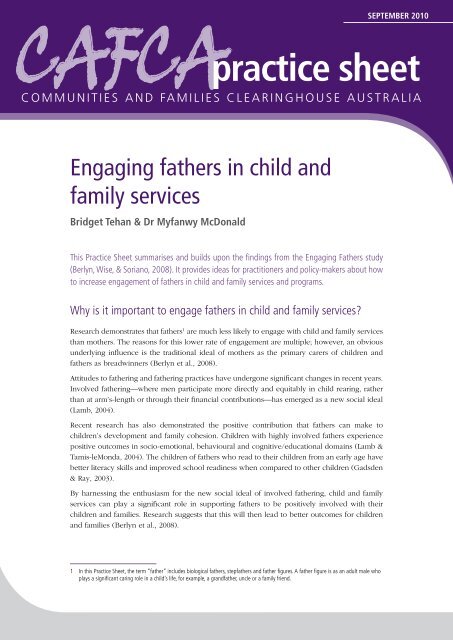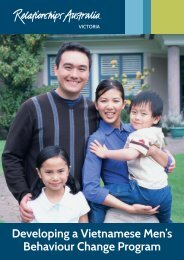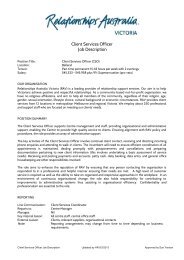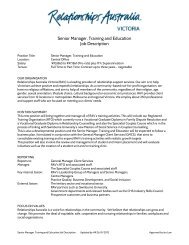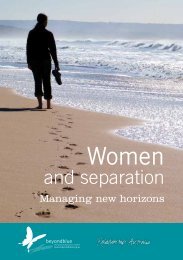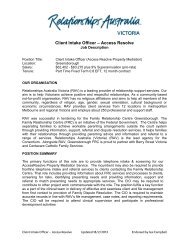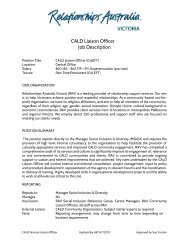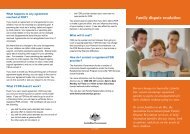Engaging fathers in child and family services - Australian Institute of ...
Engaging fathers in child and family services - Australian Institute of ...
Engaging fathers in child and family services - Australian Institute of ...
- No tags were found...
Create successful ePaper yourself
Turn your PDF publications into a flip-book with our unique Google optimized e-Paper software.
Practice considerationsPractice considerations are general pr<strong>in</strong>ciples based upon lessons from research <strong>and</strong> practicedesigned to provide additional guidance to service providers about specific issues relat<strong>in</strong>g towork<strong>in</strong>g with <strong>fathers</strong>.What methods can <strong>child</strong> <strong>and</strong> <strong>family</strong> <strong>services</strong> use to engage <strong>fathers</strong>?Many <strong>of</strong> the methods for engag<strong>in</strong>g <strong>fathers</strong> are the same as engag<strong>in</strong>g other potentially “hard toreach” groups <strong>in</strong> the community. See How to Engage Disadvantaged Families <strong>in</strong> Child <strong>and</strong>Family Services (McDonald, 2010) for more tips. This Practice Sheet focuses on what methodsappear to be specific to engag<strong>in</strong>g men <strong>in</strong> <strong>child</strong> <strong>and</strong> <strong>family</strong> <strong>services</strong>.Acknowledge men <strong>and</strong> their needs <strong>and</strong> preferencesRecruitment• Most communities have spaces where men gather (e.g., sport<strong>in</strong>g venues <strong>and</strong> events, specificworkplaces). These spaces provide opportunities for promot<strong>in</strong>g programs <strong>and</strong> recruit<strong>in</strong>g <strong>fathers</strong>.• Promot<strong>in</strong>g programs <strong>in</strong> spaces traditionally frequented by men will not necessarily reach allmen <strong>in</strong> a community. For example, men from specific cultural groups may be more likely toattend a local religious <strong>in</strong>stitution than a sport<strong>in</strong>g event.• Fathers may be attend<strong>in</strong>g non-<strong>child</strong> <strong>and</strong> <strong>family</strong> <strong>services</strong> that provide opportunities forpromot<strong>in</strong>g programs (e.g., Centrel<strong>in</strong>k, community-based welfare agencies). Workers at those<strong>services</strong> may not be aware <strong>of</strong> local programs available for <strong>fathers</strong>.• Men may be uncomfortable with programs that emphasise the provision <strong>of</strong> “support” becauseit suggests they are not cop<strong>in</strong>g.• Men are more likely to attend a <strong>child</strong> <strong>and</strong> <strong>family</strong> service if they are encouraged to do so bytheir partners. Similarly, a partner who discourages his <strong>in</strong>volvement may reduce a man’swill<strong>in</strong>gness to engage with a service.For further discussion on acknowledg<strong>in</strong>g men’s needs <strong>and</strong> preferences <strong>in</strong> service delivery, see: O’Brien <strong>and</strong>Rich (2002, pp. 26–32), Berlyn et al. (2008, pp. 24–28); Fletcher, (2004, 67–84), Lloyd et al. (2003), <strong>and</strong> NSWDepartment <strong>of</strong> Community Services (2009).Service delivery• Services that operate only dur<strong>in</strong>g bus<strong>in</strong>ess hours are most accessible to people who are homedur<strong>in</strong>g the day; the majority <strong>of</strong> those people will be parents <strong>and</strong> most <strong>of</strong>ten women.• Flexible hours <strong>of</strong> operation have a significant effect on how accessible a program is to <strong>fathers</strong>.• Positive images <strong>of</strong> men <strong>and</strong> <strong>fathers</strong> <strong>in</strong> a program sett<strong>in</strong>g <strong>and</strong> <strong>in</strong> promotional materials (suchas brochures) shows a service welcomes <strong>fathers</strong> <strong>and</strong> recognises their importance.• Research suggests that many men have a positive response to activities that provide “h<strong>and</strong>son”learn<strong>in</strong>g opportunities through activities such as cook<strong>in</strong>g <strong>and</strong> physical activity (ratherthan sem<strong>in</strong>ars <strong>and</strong> presentations).• Because <strong>child</strong> <strong>and</strong> <strong>family</strong> <strong>services</strong> are <strong>of</strong>ten staffed <strong>and</strong> attended ma<strong>in</strong>ly by women, hav<strong>in</strong>ga male staff member or male volunteers (especially “front <strong>of</strong> house”) may make men feelmore comfortable.• A program specifically for men (e.g., a “Dads” group) may make men more likely to attenda service.CAFCA Practice Sheet | 3
practice sheet• Hold<strong>in</strong>g <strong>child</strong> <strong>and</strong> <strong>family</strong> activities <strong>in</strong> “male friendly” spaces (e.g., sport<strong>in</strong>g clubs) may improvelevels <strong>of</strong> father engagement.• Some men (as well as women) may feel uncomfortable discuss<strong>in</strong>g personal issues freely <strong>and</strong>openly <strong>in</strong> a service environment. Some ways <strong>of</strong> reduc<strong>in</strong>g this discomfort are:––for workers to speak about their own experience, rather than position<strong>in</strong>g themselves asan “expert”;––<strong>in</strong>teract<strong>in</strong>g side by side rather than face to face; <strong>and</strong>––discuss<strong>in</strong>g issues whilst they are engaged <strong>in</strong> an activity (e.g., cook<strong>in</strong>g, “t<strong>in</strong>ker<strong>in</strong>g”).Questions to consider <strong>in</strong> plann<strong>in</strong>g <strong>and</strong> delivery <strong>of</strong> <strong>services</strong>:• Where do men <strong>in</strong> the local community gather? Can you promote your program <strong>in</strong> these venues?To encourage participants to attend, all potential participants were approached personally througha number <strong>of</strong> avenues <strong>in</strong>clud<strong>in</strong>g personally approach<strong>in</strong>g dads as they dropped <strong>of</strong>f <strong>and</strong> collected their<strong>child</strong>ren from school, <strong>child</strong> care <strong>and</strong> sport<strong>in</strong>g events. (Kangaroo Isl<strong>and</strong> Children’s Services, 2010)• Consider men from culturally <strong>and</strong> l<strong>in</strong>guistically diverse (CALD) backgrounds: Where do they meet? Whatchallenges might they be fac<strong>in</strong>g as <strong>fathers</strong>? How can your program develop relationships with the men <strong>in</strong> thesecommunities?The Community Development Officer drew on personal connections <strong>and</strong> engagement <strong>in</strong> other communityprograms [<strong>in</strong> order to build networks <strong>in</strong> the African community]. These <strong>in</strong>cluded personal friends with<strong>in</strong>African <strong>Australian</strong> communities, <strong>and</strong> the Bi-Cultural Community Health Workers. (Bridges for African Men<strong>and</strong> Families, AIFS, 2010b)• What type <strong>of</strong> language is used <strong>in</strong> promotional materials? Does it take <strong>in</strong>to account men’s resistance toseek<strong>in</strong>g help? Does it state what men will get out <strong>of</strong> the program <strong>and</strong> what they will be do<strong>in</strong>g at theprogram?When we put out the fliers, we make it very clear exactly what the workshop will be on <strong>and</strong> what we hopepeople will ga<strong>in</strong> by com<strong>in</strong>g to the workshop. So the dads have some sense that … they’re not just com<strong>in</strong>galong to get support. We don’t use the word support. But they’re go<strong>in</strong>g to actually learn strategies on a,b, c [<strong>and</strong>] d. (Participant, cited <strong>in</strong> Berlyn et al., 2008, p. 23)• Are there positive images <strong>of</strong> <strong>fathers</strong> <strong>in</strong> the space <strong>and</strong>/or <strong>in</strong> promotional materials? Are there positive storiesabout <strong>fathers</strong> <strong>in</strong> promotional materials?• Does your program provide “h<strong>and</strong>s on” learn<strong>in</strong>g experiences?• Is your program available outside bus<strong>in</strong>ess hours?We hold the courses both <strong>in</strong> the daytime <strong>and</strong> <strong>in</strong> the even<strong>in</strong>gs <strong>and</strong> on the weekends. We’ve repeated some<strong>of</strong> the workshops that have been highly successful <strong>and</strong> well attended, but we repeated them at differenttimes to ensure that [they are accessible] to everybody. (Participant, cited <strong>in</strong> Berlyn, et al., 2008, p. 27)For further discussion on acknowledg<strong>in</strong>g men’s needs <strong>and</strong> preferences <strong>in</strong> service delivery, see: O’Brien <strong>and</strong> Rich(2002, pp. 26–32), Berlyn et al. (2008, pp. 24–28), Fletcher, (2004, pp. 67–84), Lloyd et al. (2003), <strong>and</strong> NSWDepartment <strong>of</strong> Community Services (2009).4 | <strong>Australian</strong> <strong>Institute</strong> <strong>of</strong> Family Studies
Build staff <strong>and</strong> program capacity to engage with <strong>fathers</strong>• Whether male or female, all workers require tra<strong>in</strong><strong>in</strong>g <strong>in</strong> how to engage with <strong>fathers</strong>.• Be<strong>in</strong>g a man or a father is not necessarily go<strong>in</strong>g to enhance a practitioner’s ability to engagewith <strong>fathers</strong>—although <strong>in</strong> some circumstances <strong>fathers</strong> may feel more comfortable with a malefacilitator.• The emotional stereotyp<strong>in</strong>g <strong>of</strong> men (e.g., “men don’t express their emotions”, “men are afraid<strong>of</strong> their feel<strong>in</strong>gs”) has been shown to reduce practitioners’ effectiveness when conduct<strong>in</strong>g<strong>family</strong> relationship work.• The ability to <strong>in</strong>clude <strong>fathers</strong> <strong>in</strong> <strong>child</strong> <strong>and</strong> <strong>family</strong> <strong>services</strong> requires a range <strong>of</strong> competencies.Some <strong>of</strong> the key competencies are:––experience work<strong>in</strong>g with men;––the ability to work with <strong>fathers</strong> <strong>in</strong> a one-on-one or group sett<strong>in</strong>g;––skills <strong>in</strong> form<strong>in</strong>g productive relationships with clients;––the ability to relate to others through personal experience; <strong>and</strong>––the ability to reflect upon <strong>and</strong> respond to cultural stereotypes about men <strong>and</strong> how thesestereotypes may impact upon their own attitudes <strong>and</strong> practice.• Competency work<strong>in</strong>g with men is an ongo<strong>in</strong>g process. Practitioners will cont<strong>in</strong>ue to learn asthey cont<strong>in</strong>ue to work with men.• The follow<strong>in</strong>g program characteristics may improve capacity to engage with <strong>fathers</strong>:––consider<strong>in</strong>g how to <strong>in</strong>clude <strong>fathers</strong> at the plann<strong>in</strong>g stage <strong>of</strong> a program;––a commitment from all staff for father <strong>in</strong>clusion; <strong>and</strong>––a staff member dedicated to engag<strong>in</strong>g with men.Questions to consider <strong>in</strong> plann<strong>in</strong>g <strong>and</strong> delivery <strong>of</strong> <strong>services</strong>:• What tra<strong>in</strong><strong>in</strong>g opportunities are available for staff to help them develop the competencies to work with <strong>fathers</strong>?• Are staff given an opportunity to reflect upon stereotypes about men <strong>and</strong> how this might impact upon theirpractice?• Are there opportunities for <strong>fathers</strong> to provide feedback about the service/program?For more <strong>in</strong>formation <strong>and</strong> further discussion on build<strong>in</strong>g the capacity <strong>of</strong> staff to work with <strong>fathers</strong> see: Fletcher (2004,pp. 87–88; 2008), The University <strong>of</strong> Newcastle (2008b), Berlyn et al. (2008, p. 26), <strong>and</strong> Lloyd et al. (2003).Adopt a strengths-based approach to <strong>fathers</strong> <strong>and</strong> father<strong>in</strong>g• Research demonstrates that a strengths-based approach with parents <strong>in</strong>creases the effectiveness<strong>of</strong> a program <strong>and</strong> improves parental engagement.• A strengths-based approach to <strong>fathers</strong> <strong>and</strong> father<strong>in</strong>g is characterised by a focus upon <strong>fathers</strong>’capacities <strong>and</strong> the value <strong>of</strong> father<strong>in</strong>g. In practice this can be:––shar<strong>in</strong>g <strong>in</strong>formation with <strong>fathers</strong> about how they already contribute <strong>and</strong> how they canfurther contribute to the wellbe<strong>in</strong>g <strong>of</strong> <strong>child</strong>ren; <strong>and</strong>––resist<strong>in</strong>g an “expert” approach.• A strengths-based approach to <strong>fathers</strong> <strong>and</strong> father<strong>in</strong>g is especially important because:––<strong>fathers</strong>’ competence <strong>in</strong> deal<strong>in</strong>g with the emotional aspects <strong>of</strong> parent<strong>in</strong>g small <strong>child</strong>ren canbe underestimated with<strong>in</strong> their own families <strong>and</strong> <strong>in</strong> the general community; <strong>and</strong>CAFCA Practice Sheet | 5
practice sheet––due to stereotypical views <strong>of</strong> men’s abilities (as compared to women’s) men may notrealise their capacity to contribute positively to their <strong>child</strong>ren’s health <strong>and</strong> development.• Improv<strong>in</strong>g engagement with men requires service provision that is based on notions <strong>of</strong>equality, highlights service users’ exist<strong>in</strong>g strengths <strong>and</strong> is non-judgemental.For more <strong>in</strong>formation <strong>and</strong> further discussion on utilis<strong>in</strong>g a strengths-based (or an “anti-expert”) approach for<strong>fathers</strong>, see: NSW Department <strong>of</strong> Community Services (2009), Berlyn et al. (2008, p. 25), Fletcher (2008), <strong>and</strong>University <strong>of</strong> Newcastle (2008a).Questions to consider <strong>in</strong> plann<strong>in</strong>g <strong>and</strong> delivery <strong>of</strong> <strong>services</strong>:• Are staff aware <strong>of</strong> the strengths-based approach <strong>and</strong> how it relates to engag<strong>in</strong>g with <strong>fathers</strong>?• How is a strengths-based approach practiced <strong>in</strong> the service environment?It is always ensur<strong>in</strong>g that the men—they are the experts <strong>in</strong> their lives <strong>and</strong> I am not—ensur<strong>in</strong>g that theyare empowered to be proactive <strong>and</strong> respectful <strong>and</strong> to stay engaged with their families, their <strong>child</strong>ren <strong>and</strong>themselves; their lives... even when a man’s behaviour needs to be challenged, to have them do that <strong>in</strong>a respectful manner. (Participant, cited <strong>in</strong> Berlyn, et al., 2008, p. 24)What might engag<strong>in</strong>g <strong>fathers</strong> look like <strong>in</strong> practice?There are a number <strong>of</strong> examples with<strong>in</strong> CAFCA’s Promis<strong>in</strong>g Practice Pr<strong>of</strong>iles database <strong>of</strong> promis<strong>in</strong>g <strong>and</strong> <strong>in</strong>novativemethods that have been used by <strong>services</strong> <strong>and</strong> programs to engage <strong>fathers</strong>.For example, one parent<strong>in</strong>g support program <strong>in</strong> a geographically isolated area used <strong>in</strong>novative recruitment <strong>and</strong>retention strategies to encourage <strong>and</strong> engage parents, particularly <strong>fathers</strong> (Kangaroo Isl<strong>and</strong> Children’s Services,2008). Some features <strong>of</strong> the recruitment <strong>and</strong> retention strategies for men <strong>in</strong>cluded:• Approach<strong>in</strong>g <strong>fathers</strong> at venues where they congregate: Personally approach<strong>in</strong>g <strong>fathers</strong> at schools, <strong>child</strong>care,sport<strong>in</strong>g events, a local library <strong>and</strong> playgroups.• Partner support: By approach<strong>in</strong>g the partners <strong>of</strong> the <strong>fathers</strong>, many <strong>of</strong> them (especially those who attend parenttra<strong>in</strong><strong>in</strong>g sessions themselves) became keen for their <strong>child</strong>ren’s <strong>fathers</strong> to have access to the same quality<strong>in</strong>formation <strong>and</strong> support.• Familiar environment: A local football club was purposefully chosen as a male friendly environment to encouragedads to attend the sessions.• Program design <strong>and</strong> structure: Tim<strong>in</strong>g <strong>of</strong> the sessions takes <strong>in</strong>to consideration the target parents—if the grouptargets dads, it will be held <strong>in</strong> the even<strong>in</strong>g.For a full list <strong>of</strong> Promis<strong>in</strong>g Practice Pr<strong>of</strong>iles relat<strong>in</strong>g to the issue <strong>of</strong> engag<strong>in</strong>g <strong>fathers</strong> see:AuthorsAt the time <strong>of</strong> writ<strong>in</strong>g Bridget Tehan was a Project Officer at CAFCA. Dr Myfanwy McDonald isthe Co-ord<strong>in</strong>ator <strong>of</strong> CAFCA.AcknowledgementsThanks to Leah Bromfield, Lawrie Moloney <strong>and</strong> Daryl Higg<strong>in</strong>s for their comments <strong>and</strong> feedback.6 | <strong>Australian</strong> <strong>Institute</strong> <strong>of</strong> Family Studies
ReferencesBerlyn, C., Wise, S., & Soriano, G. (2008). <strong>Engag<strong>in</strong>g</strong> Fathers <strong>in</strong> Child <strong>and</strong> Family Services (Occasional Paper No.22). Canberra:Department <strong>of</strong> Families, Hous<strong>in</strong>g, Community Services <strong>and</strong> Indigenous Affairs.Fletcher, R. (2004). Br<strong>in</strong>g<strong>in</strong>g Fathers <strong>in</strong> H<strong>and</strong>book: How to engage with men for the benefit <strong>of</strong> everyone <strong>in</strong> the <strong>family</strong>.Newcastle, NSW: University <strong>of</strong> Newcastle & Family Action Centre.Fletcher, R. (2008). Father <strong>in</strong>clusive practice <strong>and</strong> associated pr<strong>of</strong>essional competencies (AFRC Brief<strong>in</strong>g No. 9). Melbourne:<strong>Australian</strong> <strong>Institute</strong> <strong>of</strong> Family Studies. Retrieved from Gadsden, V., & Ray, A. (2003). Children’s Academic <strong>and</strong> early literacy (ERIC Digest). Retrieved from Kangaroo Isl<strong>and</strong> Children’s Services. (2008). Parent<strong>in</strong>g KI (CAFCA Promis<strong>in</strong>g Practice Pr<strong>of</strong>ile). Retrieved from: K<strong>in</strong>g, A. (2001). <strong>Engag<strong>in</strong>g</strong> men: Creat<strong>in</strong>g cooperative environment. Sydney, NSW: Unit<strong>in</strong>gCare Burnside.Lamb, M. E. (2004). The role <strong>of</strong> the father <strong>in</strong> <strong>child</strong> development. New Jersey: John Wiley <strong>and</strong> Sons Inc.Lamb, M. E., & Tamis-LeMonda, C. S. (2004). The role <strong>of</strong> the father. In M. E. Lamb (Ed.), The role <strong>of</strong> the father (pp. 1–31).New Jersey: John Wiley <strong>and</strong> Sons Inc.Lloyd, N., O’Brien, M., & Lewis, C. (2003). Fathers <strong>in</strong> Sure Start local programs (Summary). London: University <strong>of</strong> London.McDonald, M. (2010). Are disadvantaged families hard to reach? <strong>Engag<strong>in</strong>g</strong> disadvataged families <strong>in</strong> <strong>child</strong> <strong>and</strong> <strong>family</strong> <strong>services</strong>(CAFCA Practice Sheet No. 1). Melbourne: <strong>Australian</strong> <strong>Institute</strong> <strong>of</strong> Family Studies.NSW Department <strong>of</strong> Community Services. (2009). Includ<strong>in</strong>g <strong>fathers</strong> <strong>in</strong> work with vulnerable families. Sydney: NSWDepartment <strong>of</strong> Community Services.O’Brien, C., & Rich, K. (2002). Evaluation <strong>of</strong> the Men <strong>and</strong> Family Relationships Initiative: F<strong>in</strong>al report <strong>and</strong> Supplementaryreport. Sydney: Commonwealth Department <strong>of</strong> Family <strong>and</strong> Community Services.Relationships Australia, New Town (Hobart). (2010). Bridges for African Men <strong>and</strong> Families (CAFCA Promis<strong>in</strong>g PracticePr<strong>of</strong>ile). Retrieved from The University <strong>of</strong> Newcastle. (2008a). The Pr<strong>in</strong>ciples <strong>of</strong> Father-Inclusive Practice: Retrieved 22 January, 2009, from The University <strong>of</strong> Newcastle. (2008b). Competencies (skills, knowledge <strong>and</strong> attitudes) for <strong>in</strong>clud<strong>in</strong>g <strong>fathers</strong>. Retrieved 22January, 2009, from First edition, <strong>Engag<strong>in</strong>g</strong> <strong>fathers</strong> <strong>in</strong> <strong>child</strong> <strong>and</strong> <strong>family</strong> <strong>services</strong> (by Bridget Tehan &Myfanwy McDonald), published September 2010.ISBN 978-1-921414-32-9© Commonwealth <strong>of</strong> Australia 2010This work is copyright. Apart from any use as permitted under the Copyright Act1968, no part may be reproduced by any process without prior written permissionfrom the Commonwealth. Requests <strong>and</strong> <strong>in</strong>quiries concern<strong>in</strong>g reproduction <strong>and</strong>rights should be addressed to the Commonwealth Copyright Adm<strong>in</strong>istration,Attorney-General’s Department, Robert Garran Offices, National Circuit, BartonACT 2600 or posted at .The <strong>Australian</strong> <strong>Institute</strong> <strong>of</strong> Family Studies is committed to the creation <strong>and</strong>dissem<strong>in</strong>ation <strong>of</strong> research-based <strong>in</strong>formation on <strong>family</strong> function<strong>in</strong>g <strong>and</strong> wellbe<strong>in</strong>g.Views expressed <strong>in</strong> its publications are those <strong>of</strong> <strong>in</strong>dividual authors <strong>and</strong> may notreflect <strong>Australian</strong> Government or <strong>Institute</strong> policy. The <strong>in</strong>formation <strong>in</strong> this PracticeSheet does not constitute legal advice.<strong>Australian</strong> <strong>Institute</strong> <strong>of</strong> Family StudiesLevel 20, 485 La Trobe Street, Melbourne VIC 3000 AustraliaPhone: (03) 9214 7888 Fax: (03) 9214 7839 Internet: CAFCA Practice sheets are brief, evidence-<strong>in</strong>formed resources that providean overview <strong>of</strong> a specific practice issue <strong>and</strong> practice considerations to helppractitioners reflect upon specific issues.The <strong>in</strong>formation provided <strong>in</strong> the CAFCA Practice Sheet series is for practitioners<strong>and</strong> policy-makers who plan <strong>and</strong>/or deliver <strong>services</strong> to <strong>child</strong>ren <strong>and</strong> families <strong>in</strong>Australia, especially those work<strong>in</strong>g <strong>in</strong> disadvantaged communities.The series draws upon <strong>and</strong> builds on the f<strong>in</strong>d<strong>in</strong>gs <strong>of</strong> an evaluation <strong>of</strong> a nationwidestrategy (the former Stronger Families <strong>and</strong> Communities Strategy) that wasdesigned to br<strong>in</strong>g about improved outcomes for families <strong>and</strong> young <strong>child</strong>ren.This Practice Sheet summarises <strong>and</strong> builds upon the f<strong>in</strong>d<strong>in</strong>gs from the <strong>Engag<strong>in</strong>g</strong>Fathers study by Berlyn, Wise, <strong>and</strong> Soriano (2008) which <strong>in</strong>volved <strong>in</strong>terviewswith pr<strong>of</strong>essionals who provide <strong>services</strong> to families <strong>and</strong> <strong>child</strong>ren (for more detailsregard<strong>in</strong>g the methodology see ).PS2CAFCA Practice Sheet | 7


